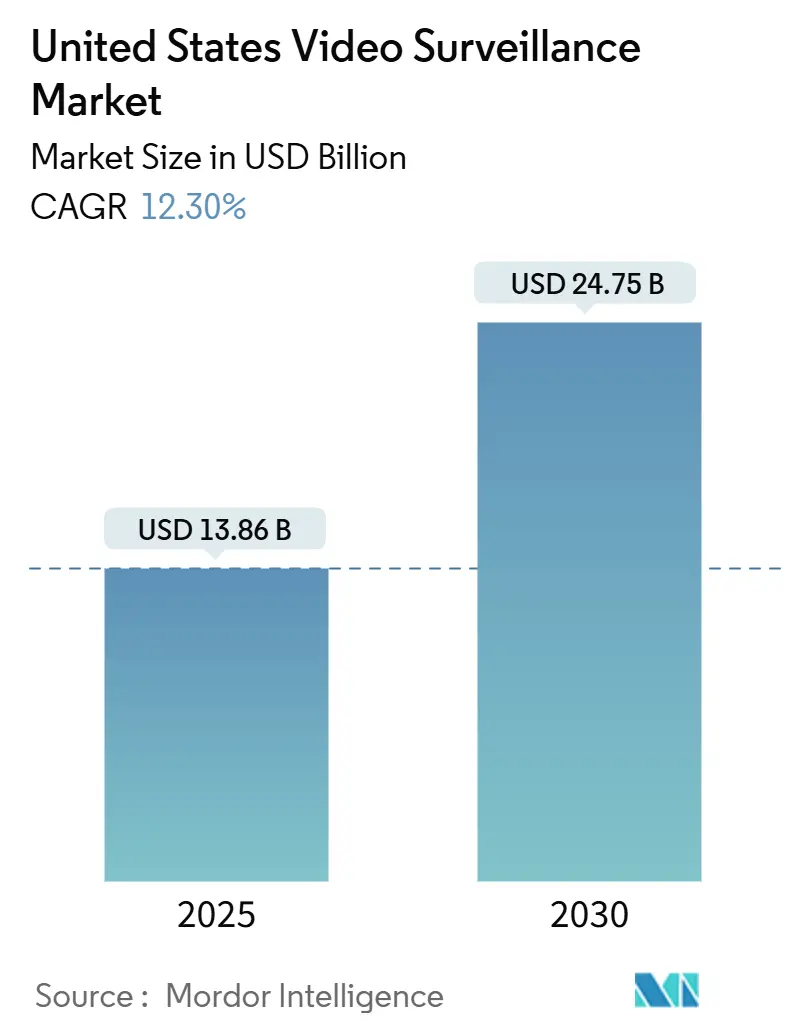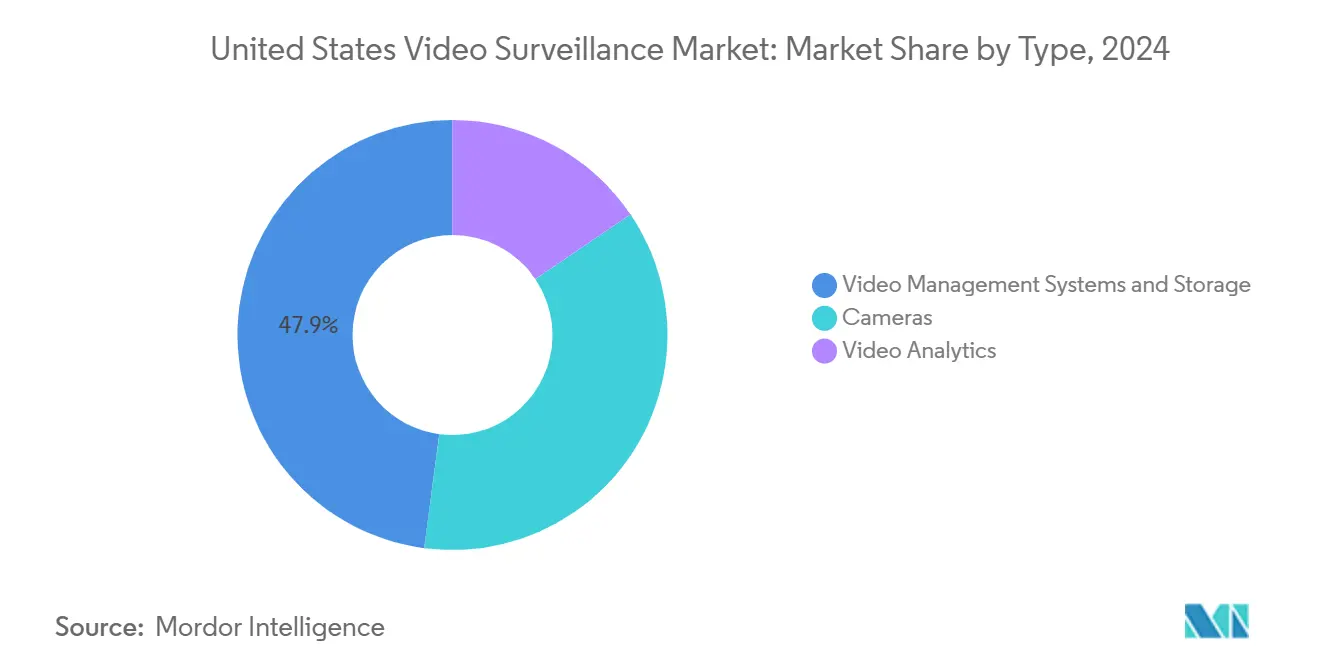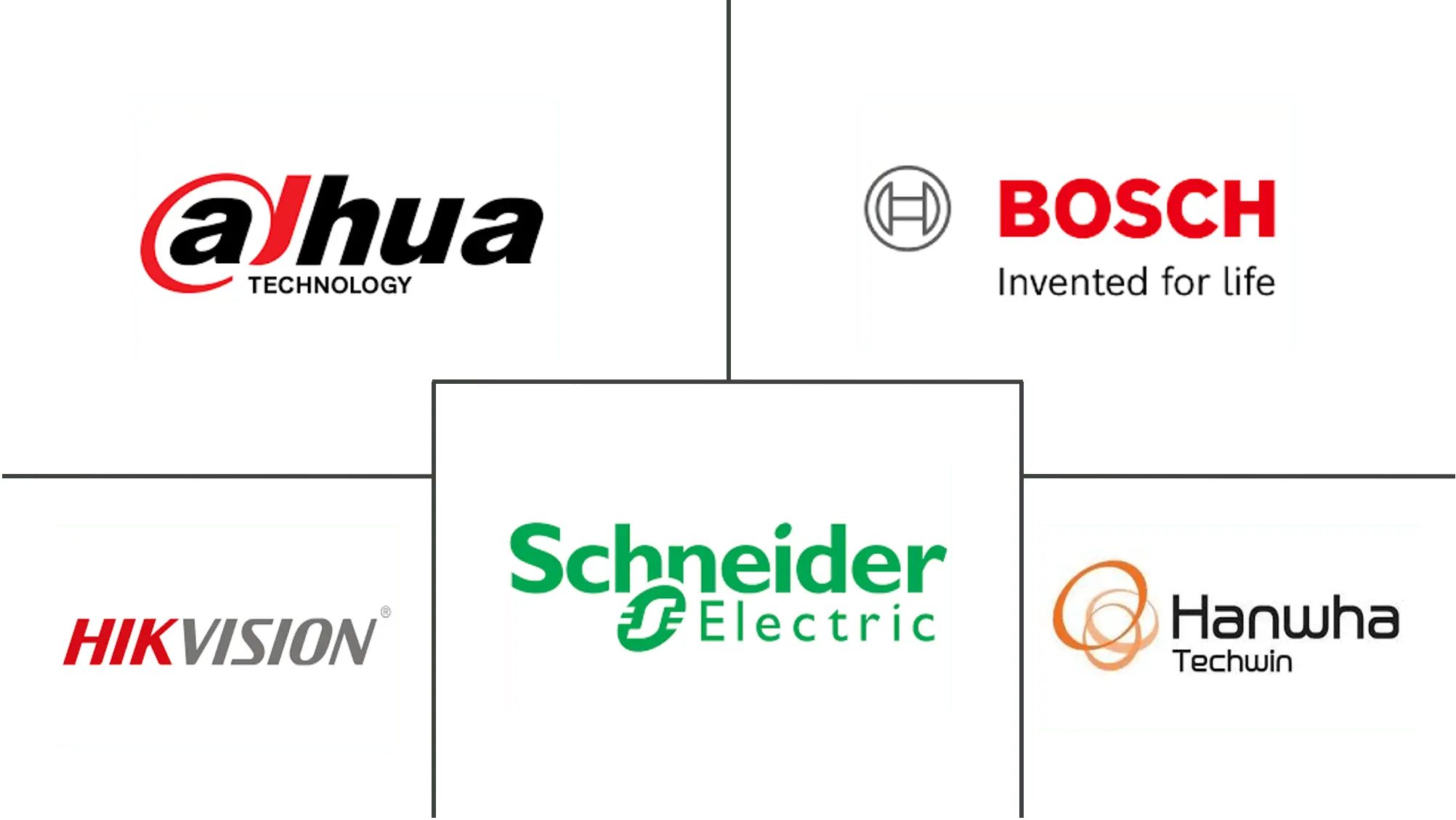United States Video Surveillance Market Size and Share

United States Video Surveillance Market Analysis by Mordor Intelligence
The United States Video Surveillance Market size is estimated at USD 13.86 billion in 2025, and is expected to reach USD 24.75 billion by 2030, at a CAGR of 12.30% during the forecast period (2025-2030).
The United States video surveillance industry is undergoing a significant technological transformation, driven by the integration of advanced analytics and AI surveillance capabilities. The emergence of sophisticated surveillance technology solutions has expanded beyond traditional security applications into business intelligence and operational efficiency tools. According to the National Retail Federation, approximately 40% of retailers have reported increased fraud detection capabilities in multichannel sales environments, highlighting the growing importance of integrated video surveillance systems. The industry has witnessed notable innovations, such as Amazon's AWS Panorama technology, which enables customized deep learning and video analytic applications for security cameras regardless of manufacturer, demonstrating the market's evolution toward more sophisticated solutions.
The integration of video surveillance with Internet of Things (IoT) technology has revolutionized monitoring capabilities and data collection methods. Modern smart surveillance solutions now incorporate multiple IoT sensors that can detect environmental factors such as air quality, noise levels, and vibrations, providing comprehensive monitoring beyond visual data. This integration has particularly impacted the transportation sector, where March Networks secured a significant $4 million contract to implement advanced video monitoring solutions across an entire bus fleet in California, incorporating cloud-based monitoring and hybrid transit recording capabilities. The convergence of IoT and video surveillance has enabled more proactive security measures and enhanced operational insights.
The adoption of surveillance technology across various industry verticals has expanded significantly, with particular emphasis on retail, banking, and transportation sectors. In the banking sector, financial institutions are increasingly implementing advanced electronic surveillance systems to combat security threats, while retailers are leveraging video analytics for both security and customer behavior analysis. Edge360, a service-disabled veteran-owned small business, launched its Surveill VMS in July 2023, initially developed for government applications but expanded to serve the private sector, demonstrating the growing demand for sophisticated digital surveillance solutions across industries. The technology has evolved to support multiple applications, from security monitoring to business intelligence gathering.
Privacy and security considerations have become paramount in the video surveillance landscape, particularly as systems become more sophisticated and interconnected. The industry faces ongoing challenges in balancing enhanced security capabilities with privacy concerns, as evidenced by the increasing scrutiny of facial recognition technologies and data protection measures. According to an Insurance Zebra survey, while 46.9% of Americans don't have home security cameras installed, those who do are increasingly demanding systems with advanced privacy protection features and secure data transmission protocols. The industry has responded with innovations in encryption technologies and privacy-preserving analytics, ensuring that surveillance technology systems maintain security while protecting individual privacy rights.
United States Video Surveillance Market Trends and Insights
Rising Security Concerns and Crime Prevention Needs
The increasing focus on security and crime prevention has become a significant driver for the United States video surveillance market. According to FBI data from October 2022, while the national burglary rate showed improvement, dropping to 271.1 incidents per 100,000 people in 2021 from 308 incidents in the previous year, the ongoing security concerns continue to drive the adoption of security camera systems. The potential threat of criminal activities has prompted authorities to install advanced surveillance equipment across various locations, with cities like Chicago implementing extensive networks of tens of thousands of cameras and cities like New Orleans, New York, and Atlanta deploying plug-in surveillance networks that integrate private business and residential feeds into crime centers.
The Department of Homeland Security's initiative to provide billions of dollars in security grants to state agencies for installing video surveillance cameras demonstrates the government's commitment to enhancing public safety infrastructure. This is further evidenced by the implementation of sophisticated surveillance technologies by law enforcement agencies, which are increasingly integrating networked cameras, automated license plate readers, and predictive policing software with AI-enhanced video analytics. The development of real-time crime centers (RTCCs) as part of state-level government bodies has led to the identification of more than 80 RTCCs across 29 states, highlighting the growing emphasis on comprehensive surveillance infrastructure.
Technological Advancements in Video Analytics and AI Integration
The integration of artificial intelligence and advanced analytics capabilities has emerged as a crucial driver for the United States video surveillance market. The industry has witnessed significant advancements in video analytics applications, with systems now capable of performing multiple functions simultaneously, including real-time detections and alerts, video search, and business intelligence gathering without requiring additional hardware installation. These technological improvements have enabled more efficient monitoring and analysis of surveillance footage, with AI-powered systems capable of detecting and analyzing various scenarios, from security breaches to customer behavior patterns.
The evolution of facial recognition technology and smart analytics has particularly transformed the surveillance landscape. Cities like Chicago and Detroit have adopted facial surveillance systems, with Detroit's million-dollar system capable of scanning live video from cameras located at businesses, schools, health clinics, and apartment buildings. The integration of deep learning techniques has enhanced the capability of surveillance systems to provide actionable insights, with features such as high-speed person finder or tracker solutions finding applications in various sectors, from airport security to shopping mall surveillance. The development of real-time video processing with video analytics has enabled faster data aggregation and visualization into dashboards, driving business insights beyond traditional security applications.
Growing Smart Home Integration and Residential Security Demands
The emergence of smart homes has significantly elevated the role of video surveillance systems in the residential segment, driving market growth through increased consumer adoption. According to industry surveys, among the 26% of US broadband households planning to purchase smart video doorbells, a majority considered artificial intelligence and advanced analytics capabilities as crucial features in their selection process. This consumer preference has led to the development of more sophisticated residential surveillance systems that combine traditional security features with smart home integration capabilities, offering homeowners comprehensive monitoring and control solutions.
The residential surveillance market has evolved to offer systems equipped with advanced features such as motion detection, night vision, and integration with broader home automation systems. Manufacturers have responded to this demand by introducing innovative products, such as touchless video doorbells with internal video analytics that can detect visitors standing on doormats and trigger automated responses. The integration of these surveillance systems with mobile applications has enabled remote monitoring and control capabilities, allowing homeowners to manage their security systems remotely while receiving instant notifications of potential security events. This convergence of smart home technology with security features has created a more robust and user-friendly surveillance ecosystem for residential applications.
Segment Analysis
Video Management Systems and Storage Segment in United States Video Surveillance Market
Video Management Systems and Storage represent the largest segment in the United States video surveillance market, commanding approximately 48% market share in 2024. The segment's dominance is driven by the increasing need for sophisticated video management system solutions that can handle massive volumes of surveillance data from multiple sources. The rising adoption of cloud-based video management systems, particularly in enterprise and government sectors, has significantly contributed to this segment's market leadership. Organizations are increasingly investing in advanced storage solutions to comply with data retention regulations and leverage video data for business intelligence. The integration of artificial intelligence and deep learning capabilities within VMS platforms has further enhanced their value proposition, enabling automated video analysis and intelligent decision-making capabilities.

Video Analytics Segment in United States Video Surveillance Market
The Video Analytics segment is experiencing the most rapid growth in the United States video surveillance market, with an expected growth rate of approximately 15% during 2024-2029. This accelerated growth is primarily driven by the increasing integration of artificial intelligence and deep learning technologies in video surveillance systems. The segment is witnessing strong demand from various sectors, including retail, transportation, and smart cities, where advanced analytics capabilities are being deployed for applications ranging from facial recognition to crowd behavior analysis. The adoption of video analytics is further boosted by its ability to transform raw video footage into actionable intelligence, enabling proactive security measures and operational optimization. Recent developments in edge computing and AI-powered analytics have made these solutions more accessible and efficient, contributing to their widespread adoption across different industry verticals.
Remaining Segments in United States Video Surveillance Market by Type
The Cameras segment continues to be a fundamental component of the video surveillance market, encompassing a wide range of products from basic surveillance cameras to sophisticated PTZ and thermal imaging devices. This segment has evolved significantly with the integration of advanced features such as high-resolution imaging, night vision capabilities, and built-in analytics processing power. The continuous innovation in camera technology, including the development of AI-enabled cameras and multi-sensor devices, maintains its crucial role in the overall surveillance ecosystem. The segment's steady growth is supported by ongoing technological advancements and the increasing demand for high-quality video capture capabilities across various applications.
Segment Analysis: By End User
National Infrastructure and City Surveillance Segment in United States Video Surveillance Market
The National Infrastructure and City Surveillance segment dominates the United States video surveillance market, accounting for approximately 47% of the total market share in 2024. This segment's prominence is driven by increasing government initiatives regarding mandatory installations of video cameras and the rising adoption of advanced surveillance solutions across major cities. Cities like Washington have implemented sophisticated movement analytics programs that utilize data from video cameras to identify and track various entities moving through the city, including vehicles, buses, pedestrians, and bikes. The integration of artificial intelligence and deep learning technologies has enhanced the capabilities of city surveillance systems, enabling features like facial recognition, real-time video processing, and advanced analytics for law enforcement agencies. Additionally, the deployment of plug-in network surveillance networks in cities like Chicago, New Orleans, New York, and Atlanta, where private businesses and homes provide feeds integrated into crime centers, has significantly expanded the scope of city-wide surveillance infrastructure.
Transportation Segment in United States Video Surveillance Market
The Transportation segment in the United States video surveillance market is experiencing significant transformation, with an expected growth rate of approximately 12% during 2024-2029. This growth is primarily driven by the increasing integration of advanced video analytics solutions in public transportation systems, railways, and logistics operations. The sector is witnessing a shift towards AI-powered video monitoring systems that can automatically analyze railroad video data, supporting safety research and operational efficiency. The implementation of sophisticated surveillance solutions in transit authorities has led to the adoption of hybrid systems that support both analog and IP cameras, allowing transportation agencies to migrate to IP video cost-effectively. Furthermore, the integration of video analytics with Department of Transportation (DoT) requirements for vehicle safety checks and the rising demand for cargo security monitoring are contributing to the segment's rapid growth.
Remaining Segments in United States Video Surveillance Market End-User Segmentation
The Commercial segment maintains a strong presence in the market, driven by the growing adoption of surveillance equipment in banking, financial institutions, and office spaces. The Retail segment focuses on loss prevention and customer behavior analytics, while the Residential segment is experiencing growth due to increasing smart home adoption and security concerns. These segments are witnessing technological advancements through the integration of AI-based analytics, cloud storage solutions, and remote monitoring capabilities. The Other End Users segment, which includes educational institutions, healthcare facilities, and manufacturing sectors, continues to adopt video surveillance systems for various applications ranging from campus security to patient monitoring and industrial safety compliance.
Competitive Landscape
Top Companies in United States Video Surveillance Market
The United States video surveillance market is characterized by continuous innovation and strategic developments from major players like Hikvision, Dahua, Axis Communications, Honeywell, and Cisco Systems. Companies are heavily investing in artificial intelligence (AI) and machine learning capabilities to enhance their surveillance solution offerings, while simultaneously developing cloud surveillance solutions to meet evolving customer demands. The industry demonstrates strong operational agility through rapid product development cycles and vertically integrated operations, enabling quick responses to market changes. Strategic partnerships with technology providers, particularly in cloud services and analytics, have become increasingly common as companies seek to strengthen their market positions. Geographic expansion strategies focus on establishing a local presence through technical support offices, while product portfolio diversification emphasizes end-to-end solutions incorporating hardware, software, and services.
Market Dominated by Global Technology Conglomerates
The United States video surveillance market exhibits a complex competitive structure with a mix of global technology conglomerates and specialized security solutions providers. Large multinational corporations leverage their extensive R&D capabilities and established distribution networks to maintain market leadership, while specialized players focus on niche segments with innovative solutions. The market demonstrates moderate consolidation, with major players continuously expanding their presence through strategic acquisitions of smaller, innovative companies, particularly those specializing in AI and analytics capabilities.
The industry has witnessed significant merger and acquisition activity, particularly focused on integrating complementary technologies and expanding market reach. Companies are increasingly pursuing vertical integration strategies, acquiring component manufacturers and software developers to strengthen their supply chains and enhance product offerings. The competitive landscape is further shaped by regulatory factors, particularly restrictions on Chinese manufacturers, which have created opportunities for US-based companies to expand their market share while fostering partnerships with domestic technology providers.
Innovation and Adaptability Drive Market Success
Success in the United States video surveillance market increasingly depends on companies' ability to develop comprehensive surveillance solution that integrate advanced technologies while maintaining strong cybersecurity measures. Incumbent players must focus on continuous innovation in AI-powered analytics, cloud integration, and edge computing capabilities while building strong partner ecosystems to maintain their market positions. The ability to provide scalable solutions that address specific vertical market needs, combined with strong after-sales support and professional services, has become crucial for maintaining a competitive advantage.
Market contenders can gain ground by focusing on specialized market segments, developing innovative solutions for emerging use cases, and building strong relationships with system integrators and channel partners. The increasing emphasis on privacy concerns and data protection regulations requires companies to demonstrate robust compliance capabilities and transparent data handling practices. Success also depends on the ability to adapt to changing end-user preferences, particularly the shift towards video surveillance as a service models and integrated security solutions that combine physical and cybersecurity capabilities.
United States Video Surveillance Industry Leaders
Dahua Technology Co. Ltd
Hikvision Digital Technology Co. Ltd
Hanwha Techwin
Schneider Electric SE
Robert Bosch GmbH
- *Disclaimer: Major Players sorted in no particular order

Recent Industry Developments
- July 2022: Konica Minolta Business Systems U.S.A., Inc. (Konica Minolta) developed a new promotion to raise understanding of its innovative security camera technologies. Its superhero concept echoes the hero/villain dynamic, urging company owners and physical security teams to consider their businesses as communities for which they serve as superheroes and protectors.
- April 2022: Qognify introduced Qognify VMS, a modern video management framework. It is designed to meet the particular physical security needs of companies all around the globe. Furthermore, it is based on the proven functionality of Qognify's famous video monitoring system Cayuga, which is used in thousands of surveillance systems worldwide.
United States Video Surveillance Market Report Scope
Video surveillance systems contain one or more video cameras connected to a network that sends the captured video or audio data to a specific location. The captured images are monitored in real-time or sent to a central location for recording and storage. Many applications, such as crime prevention, industrial process monitoring, and traffic management, are increasingly utilizing video surveillance systems.
The United States Video Surveillance Market study tracks revenues accrued from the sales of four major product categories - Cameras, Video Analytics, Video Management Systems, and Storage Systems. The United States Video Surveillance Market is Segmented by Type comprising Cameras, Video Management Systems and Storage, and Video Analytics, and by End Users, including Retail, Commercial, National Infrastructure, and City Surveillance, Transportation, Residential, among others.
The United States Video Surveillance Market is Segmented by Type (Cameras, Video Management Systems and Storage, and Video Analytics), End User (Commercial, Retail, National Infrastructure, and City Surveillance, Transportation, and Residential). The market sizes and forecasts are provided in terms of value (USD million) for all the above segments.
| Cameras |
| Video Management Systems and Storage |
| Video Analytics |
| Commercial |
| Retail |
| National Infrastructure and City Surveillance |
| Transportation |
| Residential |
| Other End Users |
| Type | Cameras |
| Video Management Systems and Storage | |
| Video Analytics | |
| End User | Commercial |
| Retail | |
| National Infrastructure and City Surveillance | |
| Transportation | |
| Residential | |
| Other End Users |
Key Questions Answered in the Report
How big is the United States Video Surveillance Market?
The United States Video Surveillance Market size is expected to reach USD 13.86 billion in 2025 and grow at a CAGR of 12.30% to reach USD 24.75 billion by 2030.
What is the current United States Video Surveillance Market size?
In 2025, the United States Video Surveillance Market size is expected to reach USD 13.86 billion.
Who are the key players in United States Video Surveillance Market?
Dahua Technology Co. Ltd, Hikvision Digital Technology Co. Ltd, Hanwha Techwin, Schneider Electric SE and Robert Bosch GmbH are the major companies operating in the United States Video Surveillance Market.
What years does this United States Video Surveillance Market cover, and what was the market size in 2024?
In 2024, the United States Video Surveillance Market size was estimated at USD 12.16 billion. The report covers the United States Video Surveillance Market historical market size for years: 2019, 2020, 2021, 2022, 2023 and 2024. The report also forecasts the US Video Surveillance Market size for years: 2025, 2026, 2027, 2028, 2029 and 2030.



